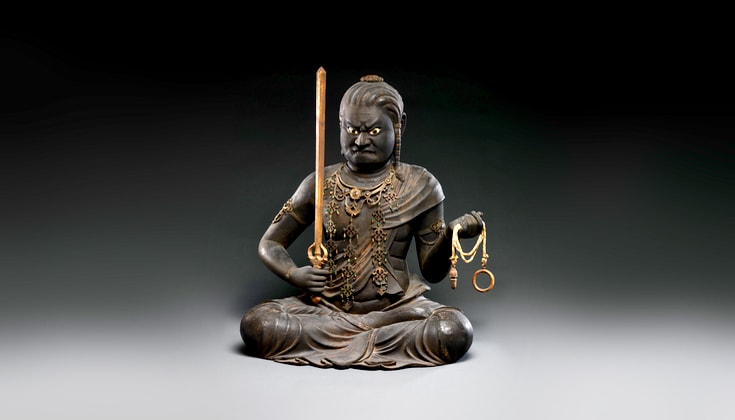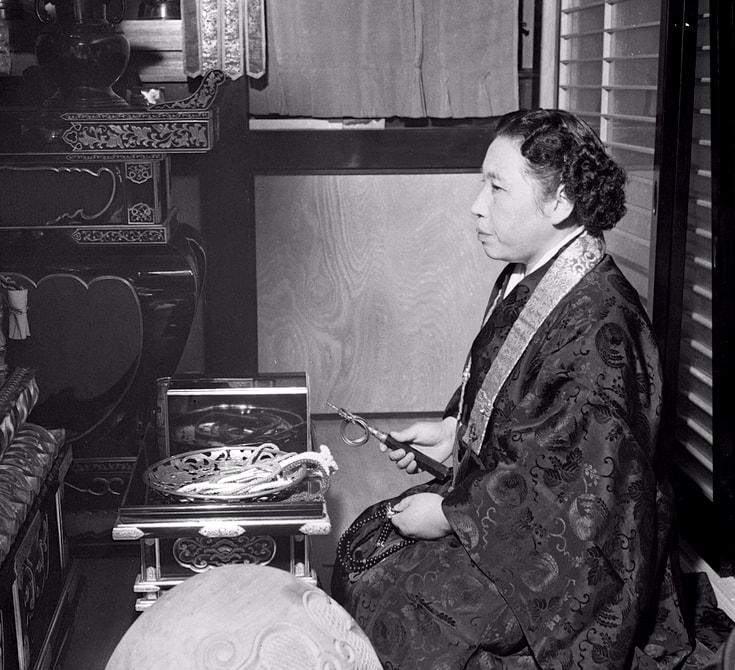
https://www.youtube.com/watch?v=PTc8X37oJBEThe dharma speaks through music—it always has, it does today. From jazz to metal to rap to emergent hybrid forms, Buddhism’s influence on the musical realm can be discovered at almost every turn.
Buddhist Music: What is it? Is it gongs, bells, and chants? Well, yes. And, no.
Sound has always been part of Buddhist practice. In most traditions, chanting and instrumental music retain a special position during ceremonies. Music often acts as an offering to the Buddha. According to the Lotus Sutra, the bodhisattva known as “Wonderful Voice” once made offerings of various kinds of music to the Buddha. Music can also be a means of memorizing sacred texts, and as a form of meditation.
As the dharma has made its way into the West—and the West has found its way into the dharma—the idea of what might constitute Buddhist music has opened up.
Haleigh Atwood writes in her article “The Power of Sound”: “For hundreds of years after the death of the Buddha, Buddhism was solely an oral tradition, dependent on sound to pass from one generation to the next. The tantric yogi and poet Milarepa taught his students about impermanence, meditation, and enlightenment through song. In many images, Milarepa is portrayed with his head cocked and a hand cupped to his ear, listening with his whole body. Sound, ancient and ubiquitous, urges us to remember what we often forget. Reverberating off the walls of history, the ring of a bell acts as a humble reminder that this sound has existed longer than any one of us. This ringing, which has brought calm to countless minds, can remind us of our interconnectedness.
As the dharma has made its way into the West—and the West has found its way into the dharma—the idea of what might constitute Buddhist music has opened up.
The first thing someone will notice when they delve into modern Buddhist-influenced music is how varied, fun, and meaningful it can be. Music plays a huge part in many people’s lives, and that isn’t going to change when they take up a Buddhist practice. You don’t have to immediately exchange your record collection for recordings of Tibetan chants. You can let your tastes provide a path toward artists that mix the music you love with an element of Buddhism. An example: If someone had come up as a punk-rock kid, they might have discovered the “first Buddhist punk band,” Ruin. If Ruin was out there waiting for you to find it in your search and their music was so good, you could reason, there has to be more.
Today, the gongs, bells, and chants of yore might be sampled or stood in for by scalding punk guitars, otherworldly vocals, or wholly unforeseen new approaches across a variety of genres. Sometimes the connections are explicit, sometimes less so—sometimes they’re bald-faced marketing choices—but like the dharma itself, Buddhist-inspired music can prompt us to see beyond the boundaries we so often take for granted. It can be (almost) anything.
 Photo by David Gabriel Fischer
Photo by David Gabriel Fischer
The Power of Sound
By Hal Atwood
Hal Atwood explores the meaning and use of sound in Buddhist practice.
Sounds — such as mantras and the ringing of bells — have always been part of Buddhist practice. Sound can rouse contemplative action and conjure diligent focus. It is powerful, but also fleeting. Constant in its impermanence, it can be a reminder that this moment is just that — only a moment.
Reciting a mantra may seem easy, but it takes discipline. We count the repetitions and strive to master the pronunciation, all while paying attention to the essence of the mantra. We may be chanting in another language, words awkwardly rolling off our tongues, but nonetheless, the sounds contain a distinct meaning and purpose.
For hundreds of years after the death of the Buddha, Buddhism was solely an oral tradition, dependent on sound to pass from one generation to the next. The tantric yogi and poet Milarepa taught his students about impermanence, meditation, and enlightenment through song. In many images, Milarepa is portrayed with his head cocked and a hand cupped to his ear, listening with his whole body. Sound, ancient and ubiquitous, urges us to remember what we often forget. Reverberating off the walls of history, the ring of a bell acts as a humble reminder that this sound has existed longer than any one of us.This ringing, which has brought calm to countless minds, can remind us of our interconnectedness.
The articles below look at the role of sound in Buddhism. Sound can motivate our spiritual practice and bring us together, like monks gathering to chant at dawn. And, of course, there is silence, the space in which sound exists, much like inner stillness is the space in which thoughts are perceived.
If the dharma can speak through the medium of sound, then each of us, as practitioners, must learn to listen with our whole body.
—Hal Atwood, editorial assistant, Lion’s Roar magazine
 The Power of Sound
The Power of Sound
By Shinso Ito
Shinso Ito, the head of the Shinnyo-en school of Buddhism, explains the role of bells and chanting in Shinnyo practice.
When I was approached about the subject of sound and spirituality, I remembered a story about my birth. I was born in the early years of the Shinnyo tradition, which was founded by my parents. On the day of my birth, people were gathered for an evening service at Shinchoji, our first temple. Its architecture was characteristic for making no distinction between spiritual training and daily life. Therefore, as soon as my mother went into labor, she simply went to a small room adjacent to the altar where she gave birth to me. So, you can say that the very first sound I heard in this world was the sound of chanting—although I have no memory of this experience myself.
Since then, I have learned much about sound and its use in spiritual practice from my parents, who are also my spiritual teachers. The founder of our tradition, my father Shinjo Ito, taught me about the powerful effects of the ritual bells we use during religious ceremonies. He explained that the true merit of the emitted sound is its ability to awaken us. Our co-founder, my mother Tomoji, also taught that bells can be used to motivate our spiritual aspirations towards practice. “Listen carefully to their rousing sound,” she would say, “encouraging us that the time to act is now.”
When we practice chanting as a form of meditative prayer, offering it with our whole being, we absorb within ourselves both the sound and energy of the wisdom and compassion imbued in the mantra.
At Shinnyo-en, we see chanting as a collective activity. In his teachings, Shinjo often spoke about the power of chanting as an active form of meditation and prayer. Chanting helps align our body, speech, and mind—our actions, words, and thoughts—towards becoming a solid foundation to support, empower, and sustain our prayers and actions. When we chant, we engage the whole of our being in a way that helps to bring out our wholesome individuality. Shinjo once instructed that “If we long to hear the awakening voices of buddhas, all we need do is take hold of Buddhist texts and read them.” He taught that as we chant, we can pay close attention to our own voices as if they are words bestowed to us from buddhas.
The wrathful protector Achala. 13th century Japan. Courtesy of The Met.
In the Shinnyo tradition, we have our own distinctive melodic chanting. In particular, there are two significant chants, the Goreiju and the Jojusan. The Goreiju, also known as “The Goreiju of Benevolence and Liberation,” is one of the mantras of Achala, an archetypal figure closely associated with Japanese esoteric Buddhism. Depicted as a wrathful being, Achala is often explained as expressing the unrelenting determination with which the Buddha attained enlightenment. At the same time, the figure also represents great loving-kindness and compassion.
Often chanted in tandem with the Goreiju is the Jojusan, a mantra in praise of ever-present shinnyo (buddhahood)—an awakening energy of wisdom and loving-kindness and compassion that fills this world. Whether at times of difficulty or joy, we chant the former to express our wish to embody Achala’s indestructible resolve to love and be kind. We chant the latter to return to the nurturing and awakening life forces (shinnyo) that embody wisdom and compassion. Together, the two chants bring out the full force of their efficacy for us to live fully in the present as we strive for the welfare of others.
If we long to hear the awakening voices of buddhas, all we need do is take hold of Buddhist texts and read them.
When these mantras are chanted, their sounds go beyond the environs of the chanter; they reverberate and are absorbed within all of us. When we practice chanting as a form of meditative prayer, offering it with our whole being, we absorb within ourselves both the sound and energy of the wisdom and compassion imbued in the mantra. The melodic chanting allows us to awaken to and enhance our own abilities so that each living person can cultivate their inner wisdom and act with compassion in their interactions with others.
Shinso Ito’s mother, Tomoji Ito.
Achala’s mantra has a long tradition of its own, but the Jojusan chant was established only recently. Both serve to illustrate how Shinnyo-en embraces tradition and innovation to respond to the varying times and circumstances. More often than not, tradition is seen as something that cannot be altered, like letters etched in stone. But Shinjo taught that tradition should not hold us back from being open to innovation. We can also look at tradition as something that evolves part and parcel with innovation.
Both tradition and innovation are imperative in accommodating a diversity of people on their various spiritual paths. They also keep us from losing sight of the ever-changing times. We hope to continue making our Shinnyo path one that lives and breathes with people, adjusting and responding as necessary, in accordance with the times, a steadfast pillar of faith and practice that supports many who are in pursuit of awakening. This makes the chanting rituals at Shinnyo-en ever more relevant in our daily efforts, through which we can connect our hearts to our forerunners in the past, reaffirm the lives we are given in the present, and — in every moment henceforth — give shape to our goals towards the future.
 Photo by Wilson U
Photo by Wilson U
The Sound of Silence
By Ajahn Amaro
Ajahn Amaro explains how to practice nada yoga and why this simple act of listening to inner sound can help you realize emptiness.
Along with the more well-known methods designed to help practitioners of Buddhist meditation ground their attention in the present moment— such as focusing on the rhythm of the breath, paying attention to the feeling of footsteps, or internally repeating a mantra—is a less familiar method known as nada yoga. Nada is the Sanskrit word for “sound,” and nada yoga means meditating on the inner sound, also referred to as the sound of silence. (Interestingly, nada is also the Spanish word for “nothing.”)
To detect the nada sound, turn your attention toward your hearing. If you listen carefully to the sounds around you, you’re likely to hear a continuous, high-pitched inner sound like white noise in the background. It is a sound that is beginningless and endless.
There’s no need to theorize about this inner vibration in an effort to figure out exactly what it might be. Just turn your attention to it. If you’re able to hear this inner sound, you can use the simple act of listening to it as another form of meditation practice, in the same way one uses the breath as an object of awareness. Just bring your attention to the inner sound and allow it to fill the whole sphere of your awareness.
In a small number of people, the inner sound is oppressively loud, usually for an organic reason. In these cases, inner listening is unlikely to be helpful as a meditation practice, since the subjective intensity of the sound makes it less useful as an object to encourage peace and clarity.
One of the great virtues of meditating on the inner sound is that it easily supports both aspects of samadhi (meditative concentration): samatha (“shamatha” in Sanskrit, meaning calmness or tranquillity) and vipassana (insight). Samadhi can be described as the fixing of the mind on a single object for a period of time. And this singleness of focus, or one-pointedness, can function in two distinct ways. The first, which is the basis of samatha, can be thought of as “the point that excludes.” It’s like using the spot-focus beam of an adjustable flashlight to lock onto a single object and block out everything else.
The second way, the basis of vipassana, can be described as “the point that includes.” The one-pointedness expands into an awareness that makes the whole experience of the present moment the object of meditation. Using the broad-focus beam of the same adjustable flashlight, all the various aspects of the present—not just a single, brightly lit spot—are encompassed in the light of awareness.
You can use the inner sound just as you would use the breath to directly support the establishment of samatha, making it the primary object of attention and letting it fill the whole space of your present experience. Very consciously, you leave everything else—the feelings in your body, the noises you hear, the thoughts that arise—on the periphery, allowing the inner sound to completely fill the focus of your attention.
If you focus on the inner sound for a length of time sufficient to bring stability, in which your mind is resting easily in the present, you can allow the sound to fall into the background. It then becomes like a screen on which all other sounds, physical sensations, moods, and ideas are projected. And because of its plainness, uniformity, and steadiness, it’s a very good screen. It doesn’t confuse or interfere with other objects that are arising. It’s like watching a movie: if you pay attention, you are aware that there’s a screen on which light is being projected. The inner sound’s presence in the background helps remind you that “this is just a movie; this is not reality.”
Listening to the inner sound helps you recollect that all mental formations, or sankharas, are unsatisfactory. If something is formed, if it’s a “thing,” there is a quality of dukkha in its very impermanence, in its very “thing-ness.” The sound’s presence can support the ease with which we see every sankhara as empty and ownerless—whether it’s a physical sensation, a visual object, a taste or smell, or a refined state of happiness. It helps us sustain an objective, unattached, unentangled participation in the present, amid the feeling of the weight of our body and the flow of our moods, whether they be tiredness, doubt, understanding, or inspiration.
The inner sound carries on in the background, reminding us that everything is Dhamma, that everything is coming and going, changing. This is a truth we may have intuited for years but often forget because of the confusion that comes from becoming attached to our personalities, memories, thoughts, and bodily discomforts.
The stress of attaching to all our experiences since birth has kept our attention entranced and bewildered. Nevertheless, we can use the presence of the nada sound to break the trance, to help us know the feelings and moods for what they are: patterns of nature coming and going and doing their thing. They are not who or what we are, and when seen with insight, they can never really satisfy or disappoint us. Inner listening leads to a knowing awareness with which we can more easily recognize the transparency, emptiness, and insubstantiality of these experiences and let them go.
Nada and the Thinking Mind
As you develop inner listening as a formal method of meditation, you may begin to notice how listening to an auditory object helps you learn to listen to your thoughts and moods with less subjectivity.
In many respects, the chatter of our thinking mind has no more meaning than the buzz of the nada sound. The chatter is just a continuous, murmuring stream of vibrations formed into conceptual patterns. So we learn to listen to our thinking with the same freedom from involvement or identification that we would have listening to a splashing fountain or a chorus of birdsong. It’s no big thing, nothing to get excited about.
Of course, that’s easier said than done, because we do tend to be infatuated with our stories, particularly the ones featuring ourselves about the good we’ve done, the bad we’ve done, what we want to do, what we hope to do, what we fear will happen to us, what others think of us, and so on. These beloved patterns are all manifestations of the “I” element, the lifetime habit we have of thinking in terms of “I” and “me” and “mine.” In the Pali canon, ahamkara, or “I-making,” and mamamkara, or “mine-making,” are the key attributes of self-view. If a story has “me” in it, it naturally tends to be much more interesting than other, more remote tales.
Accordingly, much of the development of vipassana, or insight meditation, is about learning to recognize the I-making and mine-making habits within the thoughts we experience. Ahamkara means “made of I-ness,” while mamamkara means “made of mine-ness.” True insight is not allowing those concepts to carry the mind away and, instead, seeing their emptiness and letting them go.
Nada, Emptiness, and Suchness
Most Buddhist practitioners, regardless of tradition, are familiar with what are known as the three characteristics of existence: anicca, dukkha, and anatta (impermanence, unsatisfactoriness, and not-self). These are the universal qualities of all experiences, and recognizing their presence is the most active aspect of vipassana meditation.
There are, however, other universal characteristics of existence that can be similarly employed to help free the heart from all limitation and stress. Two of these characteristics, which operate as something of a pair, are called suññata (“shunyata” in Sanskrit) and tathata, meaning, respectively, emptiness and suchness.
Emptiness expresses the idea of saying “no” to the phenomenal world: “I’m not going to believe in this. This is void, empty, hollow, not entirely real.” Suchness is connected to emptiness in the same way the right hand is connected to the left. In contrast to its partner, however, suchness expresses the idea of saying “yes” to the phenomenal world. A thought, a daffodil, or a mountain may not be a separate, solid thing, yet there is something, an ultimate reality, that underlies, permeates, embraces, and constitutes each. Suchness is thus an appreciation of the true nature of reality, and its realization can be characterized as knowing and embodying the presence of the unconditioned, the deathless, or amata-dhamma.
In the Pali canon, emptiness usually means “empty of self and what belongs to a self,” but it also refers to the insubstantiality of objects. When you stabilize the skill of attending to the nada sound, so that its shimmering, silvery tone is a constant presence, it can greatly enhance your capacity to realize both these kinds of emptiness—that of subject and object, self and other.
Inner listening facilitates the recognition of the insubstantiality of all I-, me-, and mine-based attitudes and thoughts. It is like a bright light by which we can clearly see the hollowness of bubbles as they float by. Similarly, the presence of the nada sound helps illuminate the transparency of the mental objects we experience—all the things we see, hear, smell, taste, and touch and all the memories, plans, moods, and ideas that arise in our minds. As the Buddha put it:
Material form is a lump of foam,
feeling a water bubble;
perception is just a mirage,
volitions like a plantain’s trunk,
consciousness, a magic trick—
so says the Kinsman of the Sun.
However one may ponder it
or carefully inquire,
all appears both void and vacant
when it’s seen in truth.
—“A Lump of Foam,” Samyutta Nikaya, 22.95
The nada sound can help us recognize the suchness of experience as well. Suchness is by its nature hard to pin down conceptually. But while it has a quality that may make it seem vague or unreal, ironically, that is a necessary part of its meaning. Significantly, the word the Buddha coined to refer to himself was Tathagata, meaning either “one who has come to suchness” or “one who has gone to suchness,” depending on the interpretation. So even though suchness seems intangible, it also conveys a fundamental reality.
A comparison might be made with the mathematical concept of the square root of minus one. In the world of real numbers, there is no integer that you can multiply by itself to produce minus one. If such a number did exist, however, then all sorts of interesting possibilities would unfold, as was discovered in ancient times and developed further by mathematicians in the eighteenth century.
Even though this number has imaginary status, it still manages to be essential in constructing phase-shift oscillators used for sound engineering and is put to extensive use in computer graphics, robotics, signal processing, computer simulations, and orbital mechanics. Like suchness, it has a clear and demonstrable presence in the real world.
Seeing the World in the Mind
Beyond emptiness and suchness is a third, even more subtle characteristic of existence called atammayata, which means “not made of that.”
Although we may have seen through the “I am” conceit, known as asmi-mana, traces of clinging can remain—that is, clinging to the idea of an objective world being perceived by a subjective knowing, even though no sense of “I” is discernible. There is the feeling of a “this” that is knowing a “that” and either saying “yes” to it, in the case of suchness, or “no,” in the case of emptiness.
Atammayata provides closure to the whole domain with the insight that there is no “that”; there is only “this.” It expresses the genuine collapse of both the illusion of separateness of subject and object and of the discrimination between phenomena as being somehow substantially different from each other. It helps bring about the realization that there is only the wholeness of the Dhamma, complete spaciousness and fulfillment. Then, knowing that truth, even this-ness and here-ness become meaningless.
We tend to think of the mind as being in the body, but we’ve actually got it wrong; the body is in the mind. Everything we know about the body, now and at any previous time, has been known through the agency of the mind. This isn’t to say there isn’t a physical world, just that the experience of the body, and the experience of the world, happen here, within our mind.
When we truly wake up to that here-ness, the world’s externality, its separateness, ceases. When we realize that we hold the whole world within us, its thing-ness, its other-ness, is checked, and we are better able to recognize its true nature.
The presence of the nada sound can help us realize and maintain such a perspective. The mind slowly loses its habit of becoming caught in the outflows, the asava, and thus getting lost in worldly concerns. The result is an inner composure and a freedom from the compulsions that so readily entangle us.
One way to develop this insight on a practical level is to combine listening to the nada sound with the following simple reflection. While focusing on the inner sound, recollect that the world is in your mind: “My body and the world are here in this space of awareness, permeated with the sound of silence.” This will eventually bring about a shift of vision. You will find your body, your mind, and the world arriving at a resolution—a realization of orderly perfection in which the world is balanced within the heart of vibrant silence.
https://www.youtube.com/watch?v=ojb2L9Kbyk4
_________________________________










